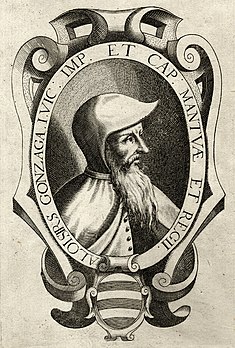
Captain of the people (Italian : capitano del popolo) was an administrative title used in Italy during the Middle Ages, established essentially to balance the power and authority of the noble families of the Italian city-states. [1]

Captain of the people (Italian : capitano del popolo) was an administrative title used in Italy during the Middle Ages, established essentially to balance the power and authority of the noble families of the Italian city-states. [1]
It was created in the early 13th century when the populares, the increasingly wealthy classes of commoners (merchants, professionals, craftsmen and, in maritime cities, ship-owners) began to acquire roles in the communal administration of various Italian city-states, and needed a municipal officeholder able to counter the political power of the nobles (called potentes), represented usually by the podestà (a title used for chief magistrates and other top administrators in medieval Italian cities). One of the first capitani del popolo was created in Bologna in northern Italy, appointed in 1228.
The capitano del popolo exercised control of the podestà, sometimes flanked by two autonomous councils with representatives of local guilds of artisans and craftsmen (Italian : arti e mestieri) and the gonfalonieri, leaders of military units connected with city's parishes.
In the Republic of Florence, a capitano del popolo existed from 1250 as part of the attempt to free the city from the rule of Frederick II.[ clarification needed ]
Such office also existed in the early stages of the Republic of Genoa, that elected Guglielmo Boccanegra as its first capitano del popolo in 1257.
Towards the second half of the 13th century, however, the communal title of capitano del popolo became a breeding ground for despotism and hereditary lordship. By gaining control of the election process for choosing the title-holder, many influential families (including aristocrats that the establishment of this office had contributed to keeping out of power) gained control over their cities and towns of residence, thus assuring their long-lasting influence and progressively transforming the comune into a signoria (i.e. lordship).

Orvieto is a city and comune in the Province of Terni, southwestern Umbria, Italy, situated on the flat summit of a large butte of volcanic tuff. The city rises dramatically above the almost-vertical faces of tuff cliffs that are completed by defensive walls built of the same stone.

Todi is a town and comune (municipality) of the province of Perugia in central Italy. It is perched on a tall two-crested hill overlooking the east bank of the river Tiber, commanding distant views in every direction. It was founded in antiquity by the Umbri, at the border with Etruria; the family of Roman Emperor Trajan came from Todi.

The Italian city-states were numerous political and independent territorial entities that existed in the Italian Peninsula from antiquity to the formation of the Kingdom of Italy in the late 19th century.

Podestà, also potestate or podesta in English, was the name given to the holder of the highest civil office in the government of the cities of Central and Northern Italy during the Late Middle Ages. Sometimes, it meant the chief magistrate of a city-state, the counterpart to similar positions in other cities that went by other names, e.g. rettori ("rectors").
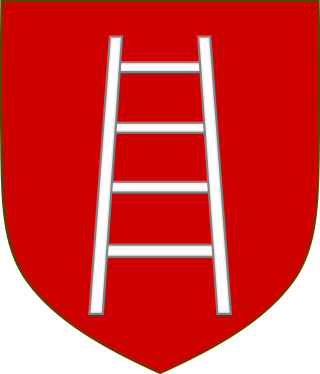
The House of Della Scala, whose members were known as Scaligeri or Scaligers, was the ruling family of Verona and mainland Veneto from 1262 to 1387, for a total of 125 years.
The Ciompi Revolt was a rebellion among unrepresented labourers which occurred in the Republic of Florence, from 1378 to 1382. Those who revolted consisted of artisans, labourers, and craftsmen who did not belong to any guilds and were therefore unable to participate in the Florentine government. These labourers had grown increasingly resentful over the established patrician oligarchy. In addition, they were expected to pay heavy taxes which they could not afford, forcing some to abandon their homes. The resulting insurrection over such tensions led to the creation of a government composed of wool workers and other disenfranchised workers which lasted for three and a half years.

The Republic of Lucca was a medieval and early modern state that was centered on the Italian city of Lucca in Tuscany, which lasted from 1160 to 1805.
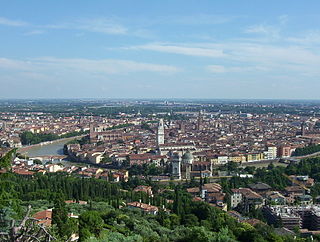
Events in the history of Verona, in Italy.

The Republic of Siena was a historic state consisting of the city of Siena and its surrounding territory in Tuscany, central Italy. It existed for over 400 years, from 1125 to 1555. During its existence, it gradually expanded throughout southern Tuscany becoming one of the major economic powers of the Middle Ages, and one of the most important commercial, financial and artistic centers in Europe.
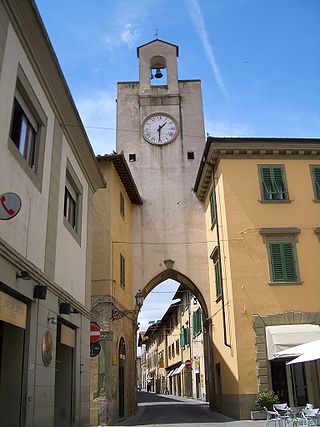
Borgo San Lorenzo is a comune (municipality) in the Metropolitan City of Florence in the Italian region Tuscany, located about 20 kilometres (12 mi) northeast of Florence. As of 31 December 2004, it had a population of 18,085 and an area of 146.1 square kilometres (56.4 sq mi).

The Simonetti family is an Italian noble family with origins in Tuscany. During the 12th century different branches in Florence, Terni, Lucca, Pistoia and Pescia developed. Other famous branches of this family were established in Jesi, Palermo, Milan and Bologna.
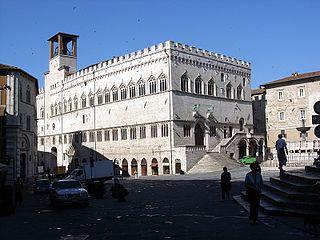
The Palazzo dei Priori or comunale is one of the best examples in Italy of a public palace from the communal era. It is located in the central Piazza IV Novembre in Perugia, Umbria. It extends along Corso Vannucci up to Via Boncambi. It still houses part of the municipality, and, on the third floor, the Galleria Nazionale dell'Umbria. It takes its name from the Priori, the highest political authority governing the city in the medieval era.
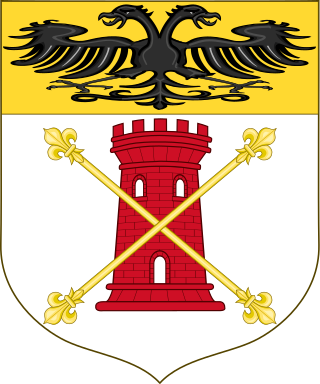
The House of Della Torre were an Italian noble family who rose to prominence in Lombardy during the 12th–14th centuries, until they held the lordship of Milan before being ousted by the Visconti.
Malatestino Malatesta was the lord of Rimini from 1312 until his death.
The Lords of Verona ruled the city from 1260 until 19 October 1387 and for ten days in 1404. The lordship was created when Mastino I della Scala was raised to the rank of capitano del popolo from that of podestà. His descendants, the Scaliger, all Ghibellines, ruled the city and its vicinity as a hereditary seigniory for a century and a half, during which the city experienced its golden age.

The Gonfalonier was the holder of a highly prestigious communal office in medieval and Renaissance Italy, notably in Florence and the Papal States. The name derives from gonfalone, the term used for the banners of such communes.

The Trinci were a noble family from central Italy, who were lords of Foligno, in Umbria, from 1305 to 1439.

The House of Bonacolsi was the name of an Italian noble family which ruled Mantua in the last quarter of the 13th century and the first quarter of the 14th. The Bonacolsi were the first lords of Mantua, preceding and creating the basis for the much more famous House of Gonzaga.
Guglielmo Boccanegra was a Genoese statesman, the first capitano del popolo of the Republic of Genoa, from 1257 to 1262, exercising a real lordship, assisted in the government by a council of 32 elders.